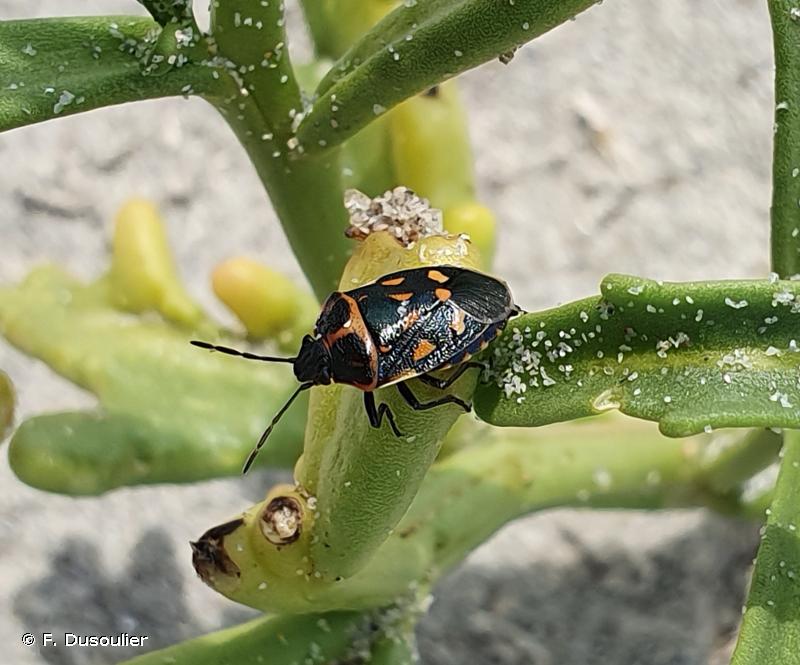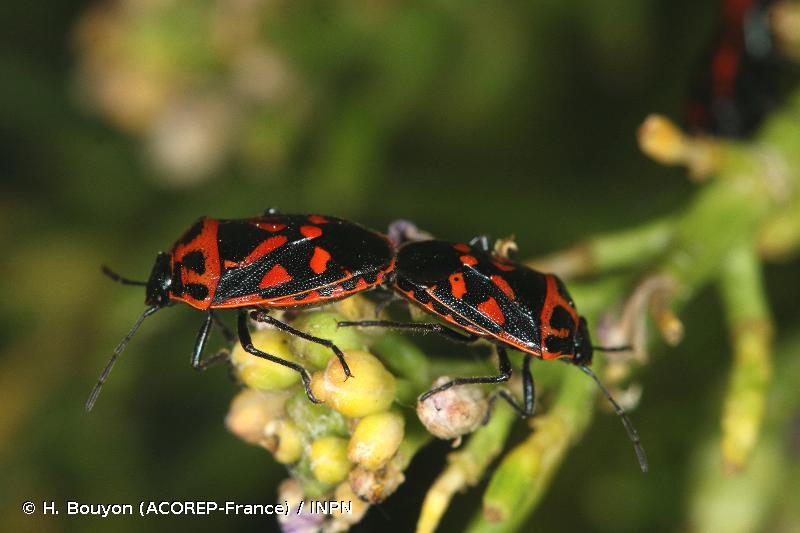
cd_nom

| Author : F. Dusoulier |
 |
To get the picture, please visit:
François Dusoulier
email: inpn@mnhn.fr
Observation partagée via l'application INPN Espèces
Any reuse of one or more photographs on this site is subject to an authorization request from the author.
Link to the Code of Intellectual Property (Legifrance)

| Author : H. Bouyon (ACOREP-France) / INPN |
 |
To get the picture, please visit:
Any reuse of one or more photographs on this site is subject to an authorization request from the author.
Link to the Code of Intellectual Property (Legifrance)
Taille : 7,2 – 8,5 mm
Diagnose :
Punaise de coloration générale noire à reflets métalliques, bariolée de taches claires rouges, orange ou blanches. Corie (partie sclérifiée de l'aile antérieure) dont la partie centrale (mésocorie) porte 2 taches claires, et dont la partie externe latérale (exocorie) est claire dans le tiers basal et sombre jusqu'à l'apex. Scutellum avec 3 taches claires, non confluentes dans sa moitié postérieure, ne formant pas de Y. Uniquement rencontrée sur le littoral sablonneux atlantique.
Détermination : Simple.
Espèces proches :
La disposition des taches sur le scutellum, les mésocories et les exocories ainsi que l'écologie de cette espèce sont caractéristiques et permet de la distinguer des autres Eurydema.
Période d'observation :
Avril à octobre, avec un pic en août.
Biologie-éthologie :
Espèce monophage strictement inféodée à la roquette de mer des côtes atlantiques, une crucifère dont elle pique les fruits (siliques).
Biogéographie et écologie :
C'est la seule espèce de Pentatomoidea avec une distribution strictement atlantique : elle est répandue le long du littoral atlantique depuis Madère, sur la péninsule Ibérique et la France, entre l'Andalousie et l'île de Jersey (Grande-Bretagne). Elle vit dans les dunes blanches sableuses, souvent au sommet des plages, dans les amoncellements d'algues à la limite des marées de vives-eaux où vit sa plante-hôte. Comme sa plante-hôte, elle ne pénètre pas à l'intérieur des terres. C'est une espèce rare à la fois dans l'espace, parce qu'elle est monophage, et que la roquette de mer a une niche écologique limitée sur les plages, et dans le temps, parce que les pics d'abondance de la punaise coïncident avec la maturation des fruits de la roquette de mer.
Roland Lupoli (),2020
Continental
Metropolitan France
Overseas
Marine
Metropolitan France
Overseas
The map presents a summary at the 10 x 10 km grid of the observation data for the species transmitted to the SINP. These data have been subjected to validation filters.
The map presents a reference distribution layer of the species at the scale of departments and marine sectors. The presence and absence data were established by expertise within a network of partners. This reference distribution is used in the validation process of the SINP data at the INPN level.
Corresponds to a report on the basis of at least one observation proved within a period of 10 years (20 years for little-known invertebrates) preceding the year and no presumption of extinction since obtaining the last data nor doubt on reproductive and implemented nature of this population. For migratory species, the presence indicated concerns areas of reproduction.
This status is based on one or more of the following criteria:
This point covers the absence, more difficult by nature to demonstrate than presence. This status is based on one or more of the following criteria:
This status must be assigned to a department in which the presence of the species is casual.
Particular case of absence due to a proven extinction less than a half century ago (older disappearances are treated as "no probable or definite").
In the state of knowledge, we can not comment on the presence or absence in the current department. This is the default status when not comprised in one of the previous categories or whenever there is doubt.
The map shows the global distribution of the species based on GBIF data (Global Biodiversity Information Facility).
